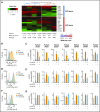Pan-SRC kinase inhibition blocks B-cell receptor oncogenic signaling in non-Hodgkin lymphoma
- PMID: 29567799
- PMCID: PMC5969377
- DOI: 10.1182/blood-2017-10-809210
Pan-SRC kinase inhibition blocks B-cell receptor oncogenic signaling in non-Hodgkin lymphoma
Abstract
In diffuse large B-cell lymphoma (DLBCL), activation of the B-cell receptor (BCR) promotes multiple oncogenic signals, which are essential for tumor proliferation. Inhibition of the Bruton's tyrosine kinase (BTK), a BCR downstream target, is therapeutically effective only in a subgroup of patients with DLBCL. Here, we used lymphoma cells isolated from patients with DLBCL to measure the effects of targeted therapies on BCR signaling and to anticipate response. In lymphomas resistant to BTK inhibition, we show that blocking BTK activity enhanced tumor dependencies from alternative oncogenic signals downstream of the BCR, converging on MYC upregulation. To completely ablate the activity of the BCR, we genetically and pharmacologically repressed the activity of the SRC kinases LYN, FYN, and BLK, which are responsible for the propagation of the BCR signal. Inhibition of these kinases strongly reduced tumor growth in xenografts and cell lines derived from patients with DLBCL independent of their molecular subtype, advancing the possibility to be relevant therapeutic targets in broad and diverse groups of DLBCL patients.
© 2018 by The American Society of Hematology.
Conflict of interest statement
Conflict-of-interest disclosure: The authors declare no competing financial interests.
Figures







Comment in
-
The future of kinase inhibitors for DLBCL?Blood. 2018 May 24;131(21):2278-2280. doi: 10.1182/blood-2018-04-841908. Blood. 2018. PMID: 29794076 Free PMC article.
Similar articles
-
Irreversible dual inhibitory mode: the novel Btk inhibitor PLS-123 demonstrates promising anti-tumor activity in human B-cell lymphoma.Oncotarget. 2015 Jun 20;6(17):15122-36. doi: 10.18632/oncotarget.3824. Oncotarget. 2015. PMID: 25944695 Free PMC article.
-
Dual Inhibition of Bruton's Tyrosine Kinase and Phosphoinositide-3-Kinase p110δ as a Therapeutic Approach to Treat Non-Hodgkin's B Cell Malignancies.J Pharmacol Exp Ther. 2017 May;361(2):312-321. doi: 10.1124/jpet.116.238022. Epub 2017 Mar 15. J Pharmacol Exp Ther. 2017. PMID: 28298527
-
A multiprotein supercomplex controlling oncogenic signalling in lymphoma.Nature. 2018 Aug;560(7718):387-391. doi: 10.1038/s41586-018-0290-0. Epub 2018 Jun 20. Nature. 2018. PMID: 29925955 Free PMC article.
-
New roles for B cell receptor associated kinases: when the B cell is not the target.Leukemia. 2019 Mar;33(3):576-587. doi: 10.1038/s41375-018-0366-8. Epub 2019 Jan 30. Leukemia. 2019. PMID: 30700840 Review.
-
Role of Bruton's tyrosine kinase in B cells and malignancies.Mol Cancer. 2018 Feb 19;17(1):57. doi: 10.1186/s12943-018-0779-z. Mol Cancer. 2018. PMID: 29455639 Free PMC article. Review.
Cited by
-
Repurposing dasatinib for diffuse large B cell lymphoma.Proc Natl Acad Sci U S A. 2019 Aug 20;116(34):16981-16986. doi: 10.1073/pnas.1905239116. Epub 2019 Aug 5. Proc Natl Acad Sci U S A. 2019. PMID: 31383760 Free PMC article.
-
The functional roles of the circRNA/Wnt axis in cancer.Mol Cancer. 2022 May 5;21(1):108. doi: 10.1186/s12943-022-01582-0. Mol Cancer. 2022. PMID: 35513849 Free PMC article. Review.
-
Serine/threonine/tyrosine kinase 1 drives pancreatic carcinogenesis via GSK3β sequestration-mediated Wnt/β-catenin pathway hyperactivation.Signal Transduct Target Ther. 2025 Jun 30;10(1):205. doi: 10.1038/s41392-025-02292-x. Signal Transduct Target Ther. 2025. PMID: 40588478 Free PMC article.
-
Pharmacologic screen identifies active combinations with BET inhibitors and LRRK2 as a novel putative target in lymphoma.EJHaem. 2022 Jul 27;3(3):764-774. doi: 10.1002/jha2.535. eCollection 2022 Aug. EJHaem. 2022. PMID: 36051080 Free PMC article.
-
Combination of Enzastaurin and Ibrutinib synergistically induces anti-tumor effects in diffuse large B cell lymphoma.J Exp Clin Cancer Res. 2019 Feb 18;38(1):86. doi: 10.1186/s13046-019-1076-4. J Exp Clin Cancer Res. 2019. PMID: 30777096 Free PMC article.
References
-
- Alizadeh AA, Eisen MB, Davis RE, et al. Distinct types of diffuse large B-cell lymphoma identified by gene expression profiling. Nature. 2000;403(6769):503-511. - PubMed
-
- Rosenwald A, Wright G, Chan WC, et al. ; Lymphoma/Leukemia Molecular Profiling Project. The use of molecular profiling to predict survival after chemotherapy for diffuse large-B-cell lymphoma. N Engl J Med. 2002;346(25):1937-1947. - PubMed
Publication types
MeSH terms
Substances
Grants and funding
LinkOut - more resources
Full Text Sources
Other Literature Sources
Miscellaneous

